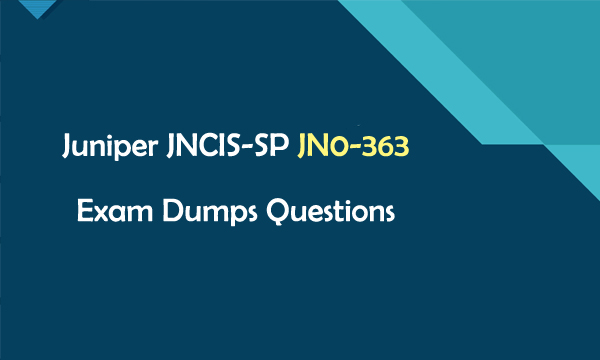Juniper JNCIS-SP JN0-363 Exam Dumps Questions
November 24,2022 07:12 AM
JN0-363 exam is a required test for Juniper JNCIS-SP certification. Service Provider Routing and Switching, Specialist (JNCIS-SP) JN0-363 exam is designed for networking professionals with beginner to intermediate knowledge of routing and switching implementations in Junos. The Juniper JNCIS-SP JN0-363 exam verifies your basic understanding of routing and switching technologies and related platform configuration and troubleshooting skills. We have cracked the latest Juniper JNCIS-SP JN0-363 exam dumps for you to prepare for JN0-363 test.

Juniper JNCIS-SP JN0-363 Exam
Juniper JN0-363 exam verifies your basic understanding of routing and switching technologies and related platform configuration and troubleshooting skills.
Exam Format: Written exam
Test Center: Pearson VUE
Exam length: 90 minutes
Exam type: 65 multiple-choice questions
Pass/fail status is available immediately
JN0-363 Service Provider Routing and Switching, Specialist (JNCIS-SP) Exam Objectives
Service Provider Routing and Switching, Specialist (JNCIS-SP) JN0-363 exam objectives cover the following details.
Protocol-Independent Routing
Open Shortest Path First (OSPF)
Intermediate System to Intermediate System (IS-IS)
Border Gateway Protocol (BGP)
Layer 2 Bridging or VLANs
Spanning-Tree Protocols
Multiprotocol Label Switching (MPLS)
IPv6
Tunnels
High Availability
Practice Juniper JNCIS-SP JN0-363 Exam Dumps
All the Juniper JN0-363 exam dumps can help you test all the above Service Provider Routing and Switching, Specialist (JNCIS-SP) JN0-363 exam objectives. Share some Juniper certification JN0-363 exam dumps below.
1. In the evaluation of an RSTP configuration BPDU, which two values are contained in the Bridge ID value? (Choose two)
A. root bridge address
B. priority
C. originating bridge address
D. port number
Answer: B, C
2. Which new field is added to an IPv6 header as compared lo IPv4?
A. version
B. checksum
C. fragment offset
D. flow label
Answer: D
3. You have been asked to configure an IPv6 address for a group of interfaces that could belong on different routers. If a packet is sent to that address, it should be received by all routers in the group.
Which address type would be suited for these requirements?
A. Unicast
B. Multicast
C. Anycast
D. Broadcast
Answer: B
4. You have configured multiple IP-IP tunnels across your network to provide connectivity to remote sites.
Which technique is used to help the IP endpoints in your network determine the optimal packet size to send across your tunnels?
A. path MTU discovery
B. fragmentation discovery
C. end-to-end MTU discovery
D. packet throughput discovery
Answer: A
5. In which two environments would BGP add value? (Choose two)
A. an enterprise environment with a single upstream connection
B. an enterprise environment with multiple upstream connections
C. a service provider environment
D. a home office environment
Answer: B, C
JN0-363 Exam Dumps PDF & SOFT | 1 Year Free Update | Money Back Guarantee
- Related Suggestion
- Pass Juniper JN0-637 Exam to Earn JNCIP-SEC Certification July 08,2024
- 2024 New Updated Juniper JNCIA-Junos JN0-105 Exam Dumps Available March 01,2024
- The Role of JNCIA-Junos Certification in Career Advancement August 16,2023
- Juniper JNCIS-SEC JN0-335 Exam Dumps Available February 06,2023
- JN0-636 JNCIP-SEC Security,Professional Dumps December 17,2022

